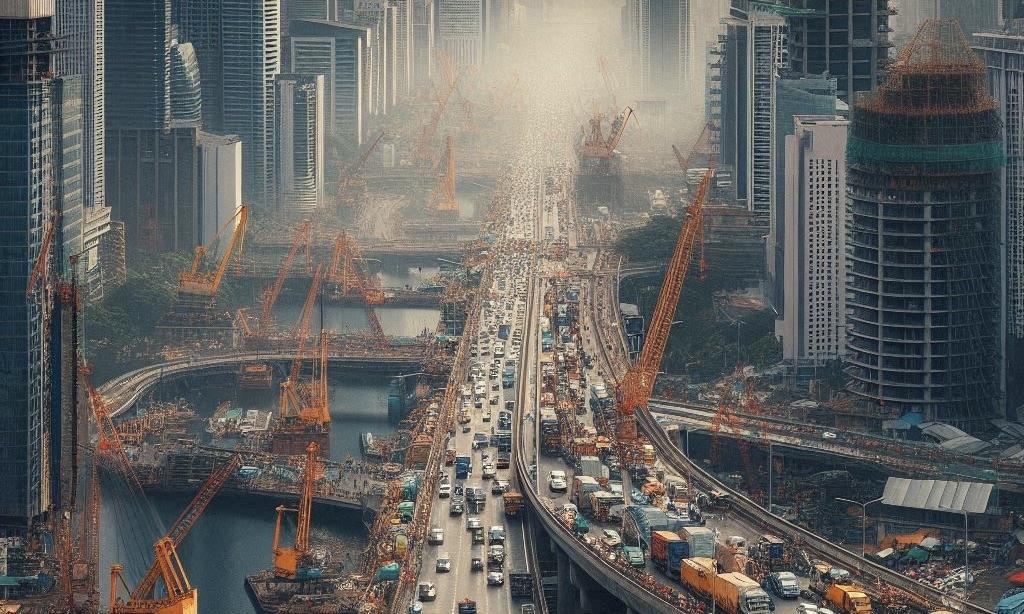The Philippines' GDP surged 6.3% in Q2, driven by increased government spending, surpassing economists' forecasts. Despite this, inflation and sluggish household expenditure present ongoing challenges. The government's infrastructure projects and defense upgrades contributed significantly to the growth.
Philippines' Q2 GDP Rises 6.3% Driven by Government Spending; Inflation Remains a Persistent Challenge
In the second quarter, the Philippines' gross domestic product increased by 6.3% due to the government's increased expenditure. However, inflation continues to pose a challenge.
A Reuters poll of economists found that the second-quarter GDP surpassed the 6.2% growth forecast and outpaced the 5.8% expansion in the year's first quarter, painting a promising picture of the Philippines' economic performance.
Government expenditures increased by 10.7% on the year, primarily due to ambitious infrastructure projects, defense equipment upgrades, and preparations for the forthcoming 2025 midterm polls, which comprise the overall GDP figures.
In the second quarter, household expenditure comprised 70% to 80% of GDP and experienced a mere 4.6% year-over-year growth.
Socioeconomic Planning Secretary Arsenio Balisacan informed reporters on August 8 that household spending during the period was "anemic," despite the fastest quarterly growth rate in the last five quarters. He also stated that "growth is not as strong as one would expect" due to the delayed effects of interest rate hikes and high inflation on consumers.
Philippines Maintains 6.5% Policy Rate as Inflation Rises; GDP Growth Revised to 5.8% in Q1
The Bangko Sentral ng Pilipinas maintains a key policy rate of 6.5%. In July, the consumer inflation rate increased to 4.4%, surpassing the central bank's target range of 2% to 4%.
On August 8, the Philippine Statistics Authority revised the January-March growth rate to 5.8% before publishing the quarterly figures. This increase from 5.7% was due to upward revisions in financial activities, wholesale and retail sales, and other factors.
The average GDP growth rate over the past two quarters was 6.0%. If this trend continues, the Philippines could achieve the government's 6% to 7% growth objective this year, positioning it among the fastest-growing economies in Southeast Asia. This would be a testament to its economic resilience.
However, Robert Dan Roces, chief economist at the Security Bank in Manila, said maintaining growth to hit that target would take a lot of work. "The sustainability may be hampered, given the decelerating GDP trend, uneven sector performance and reliance on government spending," he told Nikkei Asia. He referred to the growth trend on a quarter-on-quarter basis, which came in at 1.9% in the fourth quarter of last year, 1.1% in the first quarter of 2024, and 0.5% in the latest quarter.
Roces encouraged President Ferdinand Marcos Jr.'s government to adopt policies that would increase consumer confidence, attract investment, and facilitate agricultural reform.



 Renault Group Global Sales Rise 3.2% in 2025 on Strong International and EV Demand
Renault Group Global Sales Rise 3.2% in 2025 on Strong International and EV Demand  U.S. Stock Index Futures Steady as Markets Await Fed Policy Clues in Holiday-Thinned Trade
U.S. Stock Index Futures Steady as Markets Await Fed Policy Clues in Holiday-Thinned Trade  Lululemon Founder Chip Wilson Escalates Proxy Fight to Remove Advent From Board
Lululemon Founder Chip Wilson Escalates Proxy Fight to Remove Advent From Board  Proposed Rio Tinto–Glencore Merger Faces China Regulatory Hurdles and Asset Sale Pressure
Proposed Rio Tinto–Glencore Merger Faces China Regulatory Hurdles and Asset Sale Pressure  Netflix Stock Slips After Earnings as Soft 2026 Guidance Overshadows Subscriber Milestone
Netflix Stock Slips After Earnings as Soft 2026 Guidance Overshadows Subscriber Milestone  South Korea Factory Output Misses Forecasts in November Amid Ongoing Economic Uncertainty
South Korea Factory Output Misses Forecasts in November Amid Ongoing Economic Uncertainty  U.S. Dollar Slides Toward Biggest Annual Loss Since 2017 as 2026 Risks Loom
U.S. Dollar Slides Toward Biggest Annual Loss Since 2017 as 2026 Risks Loom  Valentino Garavani Dies at 93, Leaving Behind the Timeless Legacy of Valentino Red
Valentino Garavani Dies at 93, Leaving Behind the Timeless Legacy of Valentino Red  TikTok Expands AI Age-Detection Technology Across Europe Amid Rising Regulatory Pressure
TikTok Expands AI Age-Detection Technology Across Europe Amid Rising Regulatory Pressure  Court Allows Expert Testimony Linking Johnson & Johnson Talc Products to Ovarian Cancer
Court Allows Expert Testimony Linking Johnson & Johnson Talc Products to Ovarian Cancer  Japanese Business Leaders Urge Government Action as Weak Yen Strains Economy
Japanese Business Leaders Urge Government Action as Weak Yen Strains Economy  Rio Tinto Posts Strong Q4 Iron Ore and Copper Output on Operational Recovery
Rio Tinto Posts Strong Q4 Iron Ore and Copper Output on Operational Recovery  BHP Posts Record Iron Ore Output as China Pricing Pressures Loom
BHP Posts Record Iron Ore Output as China Pricing Pressures Loom  Trump Signs Executive Order to Limit Wall Street Investment in Single-Family Homes
Trump Signs Executive Order to Limit Wall Street Investment in Single-Family Homes  Lynas Rare Earths Shares Surge as Quarterly Revenue Jumps on Strong Prices
Lynas Rare Earths Shares Surge as Quarterly Revenue Jumps on Strong Prices  Asian Stock Markets Start New Year Higher as Tech and AI Shares Drive Gains
Asian Stock Markets Start New Year Higher as Tech and AI Shares Drive Gains 



























